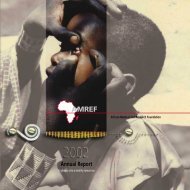Celebrating African Motherhood - Amref
Celebrating African Motherhood - Amref
Celebrating African Motherhood - Amref
You also want an ePaper? Increase the reach of your titles
YUMPU automatically turns print PDFs into web optimized ePapers that Google loves.
TANZANIA<br />
ANGAZA ZAIDI – Prevention of Mother to Child Transmission<br />
(PMTCT)<br />
Over the past ten years the death rates of mothers (578/100 000) and<br />
newborns (32 per 1,000) have remained persistently high. National<br />
AIDS-related morbidity and mortality in Tanzania is higher in women<br />
of child-bearing age, and more than 60 per cent of new infections occur<br />
among young people, particularly young women. About 90 per cent of<br />
HIV infection in children below 15 years is acquired through their mothers.<br />
Estimated prevalence of HIV among pregnant women at antenatal clinic<br />
is 8.7 per cent. Given that about 1.4 million deliveries occur annually in<br />
Tanzania, an estimated 122,000 women living with HIV deliver annually.<br />
Without intervention 25-40 per cent of these women will transmit the<br />
virus to their babies during pregnancy, delivery, or through breast-feeding.<br />
Most children born with HIV die early in their infancy, while the underfi<br />
ve mortality attributable to paediatric AIDS is 16 per cent. The Tanzanian<br />
Government introduced a programme for Prevention of Mother-to-Child<br />
Transmission (PMTCT) of HIV in 2000 as a critical element of the national<br />
HIV response. AMREF’s work in PMTCT began in 2004 as a component<br />
of the successful nation-wide ANGAZA VCT (Voluntary Counselling and<br />
Testing) Project, now called ANGAZA ZAIDI (meaning ‘to shed more light’ in<br />
Swahili). Following a decision by the Ministry of Health to allocate regions<br />
to specifi c organisations, Ruvuma Region became AMREF’s PMTCT zone.<br />
The project is implemented in three districts – Songea Urban, Songea<br />
Rural, and Namtumbo.<br />
HIV prevalence in Ruvuma, an agricultural region in southern Tanzania, is<br />
5.9, just below the national six per cent average. In 2009, the death rate<br />
for children under fi ve in the region was 90 for every 1,000 born. The<br />
mineral-rich Ruvuma attracts people from diff erent parts of the country,<br />
including neighbouring Iringa, which has the highest HIV prevalence in the<br />
country - 15 per cent. The fact that 53 per cent of women in the region have<br />
their babies at home raises the threat of HIV transmission from mothers to<br />
children, considering that 90 per cent of HIV infection in children is passed<br />
on in this way.<br />
PMTCT has traditionally been facility-based, involving training of<br />
health care providers, provision of supplies, and putting up necessary<br />
infrastructure for its implementation. A way needed to be found to take<br />
information and services to the large number of women who deliver<br />
at home. AMREF devised an integrated programme that introduced<br />
the direct involvement of communities by training community-owned<br />
resource persons (CORPS) to take health messages to the villages. Through<br />
public meetings and home-to-home visits, the CORPS talk about a range of<br />
maternal and child health issues – from antenatal care and safe delivery,<br />
to sexually transmitted illnesses, HIV and VCT. They help the community<br />
to understand what PMTCT is about, and encourage women and their<br />
husbands to go to the health centre. The project is deliberately designed<br />
to encourage men to participate because they are main decision-makers<br />
in the household; having them on board increases the chances of success<br />
of the programme.<br />
AMREF has also trained 400 health workers in 66 health centres to reinforce<br />
the information given by the community volunteers at village level, and<br />
has provided HIV test kits, delivery beds and other equipment to improve<br />
services at the facilities. With the complementary facility-based and<br />
community-based components, AMREF provides a vital link between<br />
communities and health facilities, making the project highly eff ective.<br />
FACTS AND FIGURES<br />
• Maternal mortality in Tanzania is 578 for every 100,000<br />
mothers<br />
• 90 – the percentage of HIV infection in children arising<br />
from transmission from mothers<br />
• 2,181 – the number of community service providers<br />
trained by AMREF in Ruvuma Region<br />
• AMREF partners with a total of 66 service outlets, and have<br />
trained a total of 400 service providers<br />
• Community Health Workers have reached 87,914 people in<br />
Ruvuma since 2004<br />
DONOR<br />
• PEPFAR funding through USAID<br />
47 4





